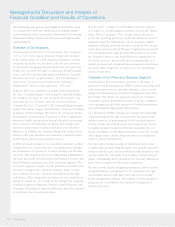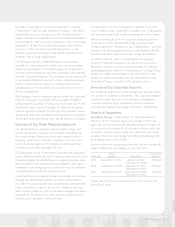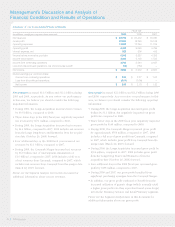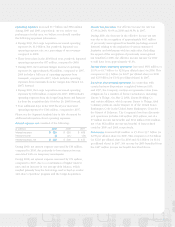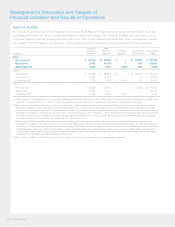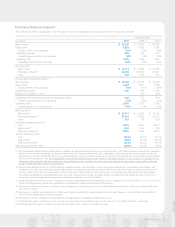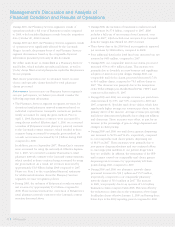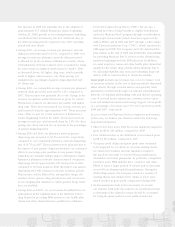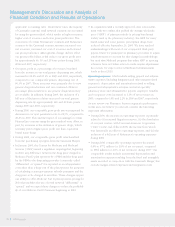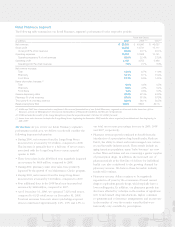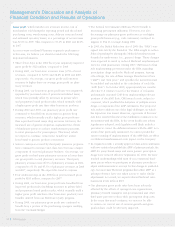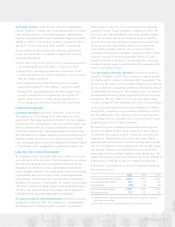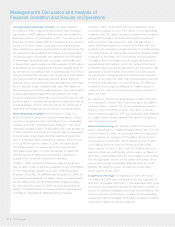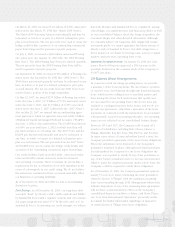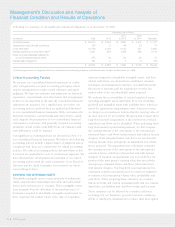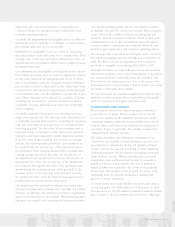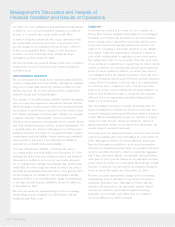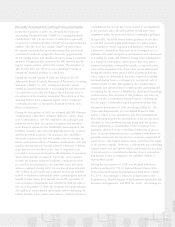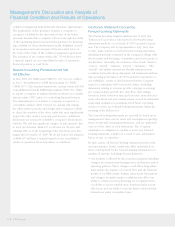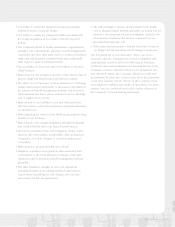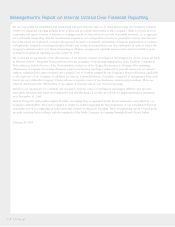CVS 2009 Annual Report Download - page 36
Download and view the complete annual report
Please find page 36 of the 2009 CVS annual report below. You can navigate through the pages in the report by either clicking on the pages listed below, or by using the keyword search tool below to find specific information within the annual report.
Management’s Discussion and Analysis of
Financial Condition and Results of Operations
• The Federal Government’s Medicare Part D benefit is
increasing prescription utilization. However, it is also
decreasing our pharmacy gross profit rates as our higher
gross profit business (e.g., cash customers) continued to
migrate to Part D coverage during 2009.
• In 2005, the Deficit Reduction Act of 2005 (the “DRA”) was
signed into law by the President. The DRA sought to reduce
federal spending by altering the Medicaid reimbursement
formula for multi-source (i.e., generic) drugs. These changes
were expected to result in reduced Medicaid reimbursement
rates for retail pharmacies. During 2007, CMS issued a final
rule implementing provisions under the DRA regarding
prescription drugs under the Medicaid program. Among
other things, the rule defines Average Manufacturer Price
(“AMP”) and “best price,” and specifies the items that must
be included and excluded in the calculation of each (the
“AMP Rule”). In October 2008, approximately ten months
after the U.S. District Court for the District of Columbia
preliminarily enjoined CMS from implementing relevant
portions of the AMP Rule, CMS issued a rule, subject to
comment, which modified the definition of multiple source
drugs, a component of the AMP calculation. The proposed
rule seeks to address one of the legal challenges on which
the injunction was issued. However, opponents of this new
rule have asserted that the revised definition continues to be
inconsistent with the DRA. In the event health care reform
legislation is adopted, such legislation will likely include a
provision to correct the definitional issues with the AMP. As a
result of the previously mentioned, we cannot predict the
extent or timing of implementation of the AMP Rule, its effect
on Medicaid reimbursement or its impact on the Company.
• In conjunction with a recently approved class action settlement
with two entities that publish the AWP of pharmaceuticals, the
AWP for many brand-name and some generic prescription
drugs were reduced effective September 26, 2009. We have
reached understandings with most of our commercial third-
party payors where we participate as pharmacy providers to
adjust reimbursements to account for this change in methodol-
ogy, but most state Medicaid programs that utilize AWP as a
pricing reference have not taken action to make similar
adjustments. As a result, we expect reduced Medicaid reim-
bursement levels in fiscal 2010.
• Our pharmacy gross profit rates have been adversely
affected by the efforts of managed care organizations,
pharmacy benefit managers and governmental and other
third-party payors to reduce their prescription drug costs.
In the event this trend continues, we may not be able
to sustain our current rate of revenue growth and gross
profit dollars could be adversely impacted.
Gross profit, which includes net revenues less the cost of
merchandise sold during the reporting period and the related
purchasing costs, warehousing costs, delivery costs and actual
and estimated inventory losses, as a percentage of net revenues
was 30.0% in 2009. This compares to 30.1% in 2008 and 29.1%
in 2007.
As you review our Retail Pharmacy segment’s performance
in this area, we believe you should consider the following
important information:
• Three fewer days in the 2009 fiscal year negatively impacted
gross profit by $123 million, compared to 2008.
• During 2009, our front-store revenues were 32.5% of total
revenues, compared to 32.5% and 32.2% in 2008 and 2007,
respectively. On average, our gross profit on front-store
revenues is higher than our average gross profit on phar-
macy revenues.
• During 2009, our front-store gross profit rate was negatively
impacted by increased sales of promotional related items,
which were partially offset by increases in private label
and proprietary brand product sales, which normally yield
a higher gross profit rate than other front-store products.
• During 2009 and 2008, our pharmacy gross profit rate
continued to benefit from an increase in generic drug
revenues, which normally yield a higher gross profit rate
than equivalent brand name drug revenues. However, the
increased use of generic drugs has augmented the efforts
of third-party payors to reduce reimbursement payments
to retail pharmacies for prescriptions. This trend, which
we expect to continue, reduces the benefit we realize
from brand to generic product conversions.
• Sales to customers covered by third-party insurance programs
have continued to increase and, thus, have become a larger
component of our total pharmacy business. On average, our
gross profit on third-party pharmacy revenues is lower than
our gross profit on cash pharmacy revenues. Third-party
pharmacy revenues were 96.9% of pharmacy revenues in 2009,
compared to 96.1% and 95.3% of pharmacy revenues in 2008
and 2007, respectively. We expect this trend to continue.
• Four additional days in the 2008 fiscal year increased gross
profit by $190 million, compared to 2007.
• During 2008, our front-store gross profit rate benefited from
improved product mix (including increases in private label
and proprietary brand product sales, which normally yield a
higher gross profit rate than other front-store products) and
benefits derived from our ExtraCare loyalty program.
• During 2008, our pharmacy gross profit rate continued to
benefit from a portion of the purchasing synergies resulting
from the Caremark Merger.
CVS Caremark
32


